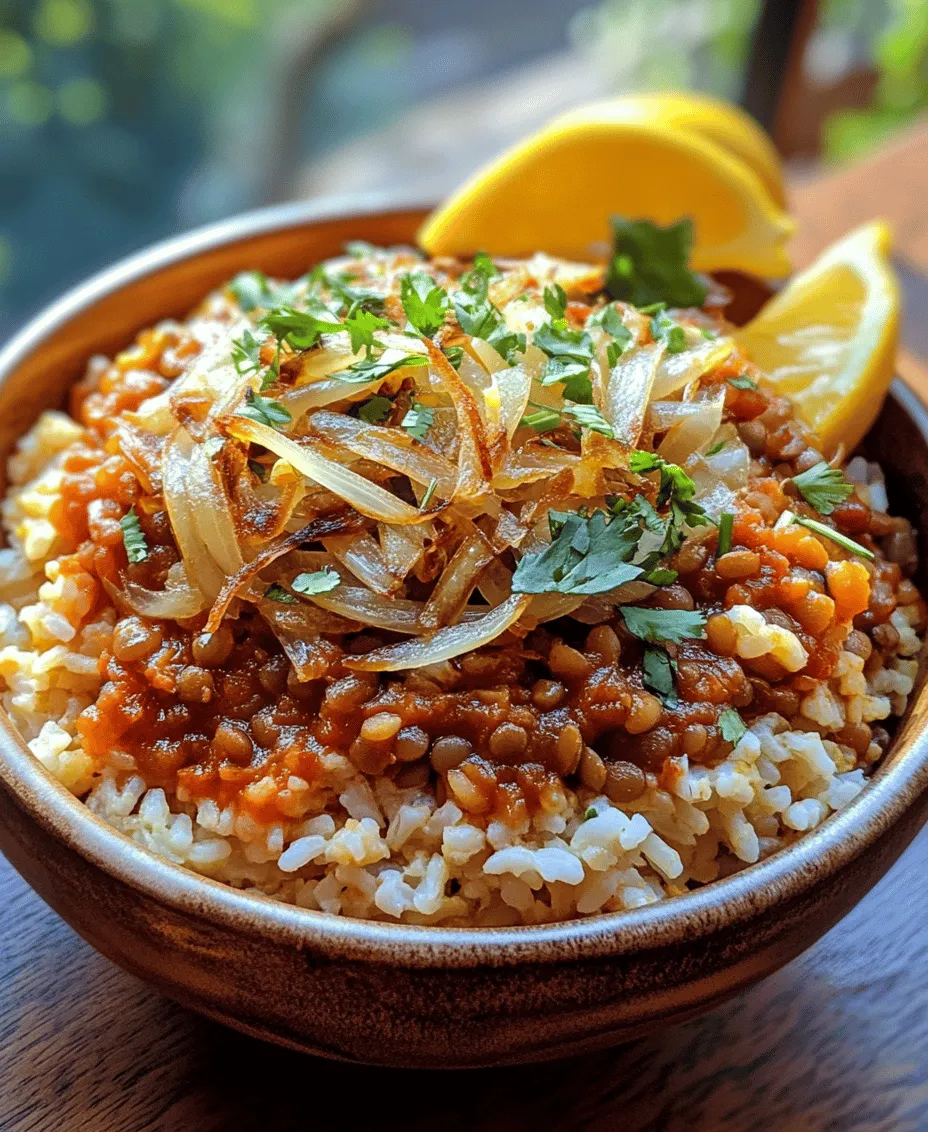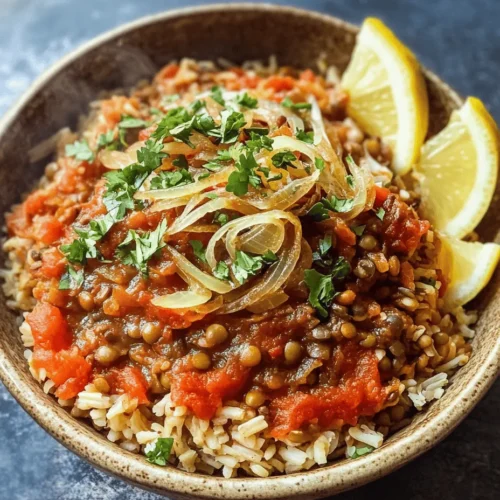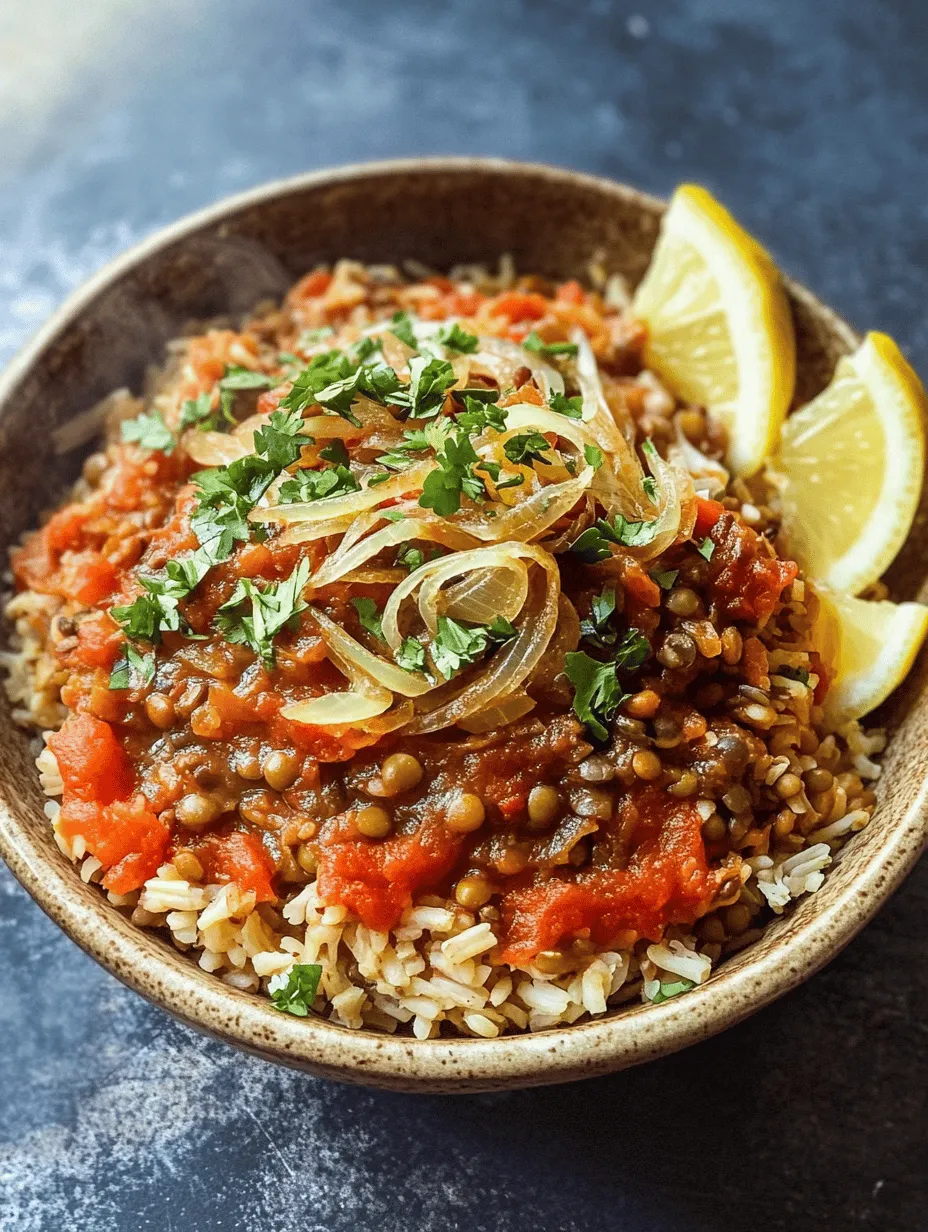Introduction
Koshari, often hailed as Egypt’s national dish, is a vibrant and hearty meal that encapsulates the essence of Egyptian cuisine. This dish is a delightful blend of flavors and textures, combining rice, lentils, and pasta, topped with a zesty tomato sauce and a sprinkle of crispy onions. It reflects the soul of Egyptian culture, showcasing a rich culinary heritage that has stood the test of time. The appeal of Koshari lies not only in its comforting taste but also in its ability to bring people together, making it a staple for families and street vendors alike.
The origins of Koshari can be traced back to the 19th century, where it emerged as a popular street food, gaining a significant foothold in Egyptian society. Its affordability and nutritional value made it an accessible choice for all, from the bustling markets of Cairo to home kitchens across the country. With its combination of carbohydrates, proteins, and spices, Koshari serves as a complete meal, embodying the spirit of Egyptian hospitality.
Understanding Koshari: A Cultural Staple
Historical Context of Koshari in Egypt
The history of Koshari is as rich as its flavor profile. Originally, it is believed that Koshari was influenced by various culinary traditions, including Italian and Indian, which contributed to its unique composition. The dish gained prominence during the British occupation of Egypt in the 19th century when it became a popular street food among workers and students. Its humble beginnings as a meal for the masses transformed it into a beloved national dish, cherished by Egyptians from all walks of life.
Koshari’s evolution is a testament to its adaptability, with each region in Egypt adding its twist to the recipe. As it traveled beyond the borders of Cairo, local ingredients and cooking methods influenced its preparation, resulting in delightful variations. Whether served in a modest home or a bustling restaurant, Koshari remains a symbol of Egyptian identity and pride.
Nutritional Benefits of Koshari as a Plant-Based Meal
One of the most appealing aspects of Koshari is its nutritional profile. As a plant-based meal, it is naturally rich in dietary fiber, protein, and essential nutrients. The combination of lentils and rice provides a complete amino acid profile, making it an excellent source of plant-based protein for vegetarians and vegans. Additionally, the use of whole grains contributes to heart health and helps regulate blood sugar levels.
The inclusion of spices such as cumin and garlic not only enhances the dish’s flavor but also offers various health benefits. These spices are known for their anti-inflammatory properties and can aid digestion, making Koshari not just a delicious meal, but a wholesome choice for health-conscious individuals.
Key Ingredients for Hearty Egyptian Koshari
To create a truly authentic Koshari, understanding the key ingredients is crucial. Each component plays a vital role in building the dish’s flavor and texture.
Overview of Essential Ingredients
1. Lentils: Typically, brown or green lentils are used in Koshari. They provide a hearty base and a good source of protein.
2. Rice: Long-grain rice is preferred for its fluffy texture. It absorbs the flavors of the spices and complements the lentils beautifully.
3. Pasta: Small pasta shapes like macaroni or vermicelli add an interesting texture and make the dish more filling.
4. Tomato Sauce: A homemade tomato sauce seasoned with garlic and cumin gives Koshari its signature flavor.
5. Onions: Crispy fried onions are a must for garnish, adding a delightful crunch and sweetness that balances the dish’s flavors.
6. Garlic and Spices: Garlic, cumin, and coriander enhance the dish’s depth and aroma.
Importance of Each Ingredient in Flavor and Texture
– Lentils provide a nutty flavor and a creamy texture when cooked, serving as a hearty base that holds the other ingredients together.
– Rice acts as a neutral canvas that absorbs the robust flavors of the spices and sauce.
– Pasta contributes a delightful chewiness, making each bite varied and satisfying.
– Tomato Sauce infuses Koshari with a tangy flavor, while the garlic and spices elevate its complexity.
– Onions, when fried to a golden crisp, add a sweet and savory element, contrasting beautifully with the other savory components.
Substitutions and Variations for Dietary Preferences
Koshari is incredibly versatile, allowing for various substitutions to accommodate dietary preferences:
– Gluten-Free: Substitute the pasta with gluten-free varieties, such as rice noodles or quinoa, to maintain the dish’s integrity.
– Low-Carb: For a lower carbohydrate option, replace the rice and pasta with cauliflower rice or spiralized vegetables.
– Additional Proteins: For those looking to increase protein content, consider adding chickpeas or tofu, which pair well with the existing flavors.
Step-by-Step Preparation of Koshari
Creating the perfect Koshari requires attention to detail, particularly in the preparation of the lentils and rice. Follow these steps to ensure each component is cooked to perfection.
Preparing the Lentils: Techniques for Perfect Texture
1. Rinse the Lentils: Start by rinsing 1 cup of brown or green lentils under cold water to remove any debris or impurities.
2. Soak (Optional): While not necessary, soaking lentils for 30 minutes can help reduce cooking time and enhance digestibility.
3. Cook the Lentils: In a pot, combine the rinsed lentils with 3 cups of water. Bring to a boil, then reduce heat to a simmer. Cook for about 20-25 minutes, or until the lentils are tender but not mushy. Drain excess water and set aside.
Cooking the Rice: Tips for Fluffiness
1. Rinse the Rice: Rinse 1 cup of long-grain rice under cold water until the water runs clear. This step removes excess starch and prevents the rice from becoming gummy.
2. Toast the Rice (Optional): For added flavor, consider toasting the rinsed rice in a dry skillet for a few minutes until slightly golden before cooking.
3. Cook the Rice: In a separate pot, combine the rinsed rice with 2 cups of water and a pinch of salt. Bring to a boil, then cover and reduce heat to low. Allow it to simmer for about 15-20 minutes until the water is absorbed and the rice is fluffy. Remove from heat and let it sit, covered, for 5 minutes before fluffing with a fork.
By following these preparation steps carefully, you can ensure that both the lentils and rice contribute to the overall texture and flavor of your Koshari. In the following sections, we’ll delve into the remaining ingredients and complete the preparation process, allowing you to delight in this cherished Egyptian dish.

Pasta Cooking: Achieving the Right Consistency
The first step in perfecting your Hearty Egyptian Koshari is cooking the pasta to the right consistency. This dish typically incorporates two types of pasta: small elbow macaroni and vermicelli. Start by bringing a large pot of salted water to a rolling boil. Once boiling, add the elbow macaroni and cook according to the package instructions, usually around 7-9 minutes, until al dente. You want the pasta to have a slight bite, as it will continue to absorb flavors from the sauce after cooking.
While the macaroni cooks, prepare the vermicelli. In a separate small saucepan, melt a tablespoon of butter or oil over medium heat and add the vermicelli. Stir frequently until the pasta turns golden brown and fragrant. This only takes a couple of minutes, so keep a close eye to prevent burning. Once the vermicelli is toasted, add it to the pot of boiling water with the macaroni for the last 2-3 minutes of cooking. This way, both types of pasta can finish cooking together, allowing them to absorb each other’s flavors. When both pastas are cooked, drain them well and set aside, ready for the assembly of the Koshari.
Sautéing Onions: The Art of Caramelization for Depth of Flavor
Caramelized onions are one of the standout elements of Koshari, providing a rich, sweet, and slightly tangy flavor that complements the earthy lentils and tangy tomato sauce. Begin by slicing two large onions thinly. In a large skillet, heat about 4 tablespoons of vegetable oil over medium heat. Once the oil is hot, add the sliced onions, stirring occasionally to ensure even cooking.
As they cook, the onions will begin to soften and release their moisture. This process can take around 15-20 minutes. Patience is key; you want the onions to caramelize slowly, turning a deep golden brown without burning. If they start to stick to the pan or brown too quickly, lower the heat and add a splash of water to deglaze. Once the onions are beautifully caramelized, season them with a pinch of salt to enhance their sweetness and remove them from the heat.
Building the Sauce: Balancing Spices with Tomatoes
The sauce is a vital component of Koshari, tying together the various ingredients with its robust flavors. To create the sauce, start by heating 2 tablespoons of oil in a saucepan over medium heat. Add 4-5 cloves of minced garlic and sauté until fragrant, about 30 seconds. Be careful not to let the garlic burn, as this will impart a bitter taste to the sauce.
Next, add a can (about 14 ounces) of crushed tomatoes to the pan, along with 1 tablespoon of tomato paste for added richness and depth. Season the mixture with a teaspoon each of cumin, coriander, and paprika, along with a pinch of cayenne pepper for a subtle kick. Stir well to combine the spices with the tomatoes and allow the sauce to simmer gently for about 10-15 minutes. This allows the flavors to meld together and thicken slightly. Taste the sauce and adjust the seasoning with salt and pepper as needed.
Combining Ingredients: Layering for Optimal Flavor Distribution
Once all your components are ready, it’s time to assemble your Koshari. This dish is traditionally served in layers, showcasing the different textures and flavors. In a large serving dish or individual bowls, start with a base layer of the cooked lentils. Next, add a layer of the cooked pasta mixture, followed by a generous spoonful of the tomato sauce.
To finish, top with the caramelized onions, allowing their sweetness to contrast with the tangy sauce and savory lentils. For those who love a bit of heat, consider drizzling some spicy sauce or chili paste over the top. The combination of textures – from the creamy lentils and tender pasta to the crunchy onions – creates a delightful eating experience.
Serving Suggestions for Koshari
Traditional Serving Methods and Presentation
Koshari is often served as a communal dish, allowing family and friends to gather around and help themselves. For an authentic presentation, serve it in a large, shallow dish, allowing the layers to be seen. This not only makes for a beautiful presentation but also encourages sharing and enjoying the meal together, which is central to Egyptian culture.
Recommended Garnishes and Accompaniments
While Koshari is hearty and flavorful on its own, there are some traditional garnishes that can elevate the experience. Consider serving it with a side of pickled vegetables, such as turnips or carrots, which add a refreshing crunch and acidity to balance the richness of the dish. Additionally, serving a simple salad of cucumbers and tomatoes dressed with lemon and olive oil can provide a refreshing contrast.
A sprinkle of fresh herbs, such as parsley or cilantro, can also add a burst of color and freshness to the dish. For those who enjoy a bit of heat, a side of spicy sauce made from hot peppers and vinegar can be offered for drizzling on top.
Pairing Options with Beverages or Side Dishes
Koshari pairs beautifully with a variety of beverages. For a traditional touch, consider serving it with a glass of Egyptian hibiscus tea or a light, refreshing lemonade. If you prefer alcoholic beverages, a crisp white wine or a light beer can complement the spices and flavors of the dish.
The Experience of Eating Koshari
Describing the Flavor Profile and Texture
The experience of enjoying Koshari is truly unique. Each bite offers a harmonious blend of flavors and textures. The lentils provide a hearty base, while the pasta adds a comforting quality. The tomato sauce is tangy and slightly sweet, enhanced by the aromatic spices that create a warm depth of flavor. The caramelized onions add a sweet crunch, contrasting beautifully with the soft textures of the lentils and pasta. Together, they create a satisfying and wholesome meal that is both filling and comforting.
Personal Anecdotes or Stories Related to Enjoying Koshari
For many, Koshari is not just a meal but a beloved tradition. Growing up, I remember my family gathering around the table, eagerly awaiting the arrival of this dish. The aroma of caramelized onions and simmering tomato sauce would fill our home, drawing everyone to the kitchen. Sharing Koshari was always a communal affair, with everyone contributing their favorite toppings and garnishes. It was a moment of togetherness, laughter, and an appreciation for the simple yet delicious flavors of our heritage.
The Communal Aspect of Sharing Koshari in Egyptian Culture
In Egypt, sharing Koshari reflects the communal spirit inherent in the culture. It’s a dish that brings people together, whether at home or at street vendors. In bustling Cairo, Koshari stalls are a common sight, where families and friends gather to enjoy this beloved dish. The act of sharing a meal fosters connections and conversations, making Koshari not just food, but a cultural experience rich in history and tradition.
Conclusion
In summary, Koshari is a hearty, flavorful dish that embodies the essence of Egyptian cuisine. With its layers of pasta, lentils, caramelized onions, and robust tomato sauce, it represents comfort food at its finest. Not only is Koshari a delicious meal, but it is also a celebration of togetherness and tradition, making it a perfect centerpiece for gatherings.
I encourage you to try making Koshari at home. Engage with the cooking process, enjoy the aromas that fill your kitchen, and share the experience with loved ones. Cooking is not just about the final dish, but the joy of preparation, sharing, and connecting with those around you. So gather your ingredients, invite friends or family, and indulge in the delightful experience of creating and enjoying this Hearty Egyptian Koshari.



